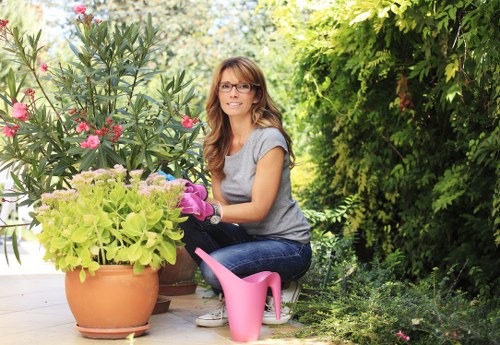Hedge Trimming in Garden Fence Replacement
When it comes to maintaining the beauty and functionality of your outdoor space, hedge trimming plays a crucial role, especially during garden fence replacement. Properly trimmed hedges not only enhance the aesthetic appeal of your property but also facilitate the seamless installation of new fences. This article explores the importance of hedge trimming in the context of garden fence replacement, offering valuable insights and best practices to ensure a harmonious and well-maintained landscape.
Integrating hedge trimming with garden fence replacement can significantly improve the overall look and health of your garden. Whether you are installing a new wooden fence, metal barrier, or any other type of garden fence, maintaining your hedges ensures that the new installation complements your existing greenery.
Enhancing the Appearance

A well-trimmed hedge provides a clean and organized backdrop for your new fence, creating a cohesive and visually appealing boundary. By removing overgrown branches and shaping your hedges, you allow the fence to stand out, making it a striking focal point in your garden.
Consistency in the height and shape of your hedges ensures that the fence appears integrated into the landscape rather than an afterthought. This meticulous attention to detail can greatly elevate the curb appeal of your home, making it more inviting and attractive.
Additionally, hedge trimming can help in preventing any unsightly overgrowth from overshadowing the new fence, ensuring that both elements coexist harmoniously.
Proper hedge trimming also contributes to the overall symmetry and balance of your garden. By maintaining uniformity in your hedges, you create an atmosphere of order and tranquility, which is essential for a pleasing outdoor environment.
Moreover, trimmed hedges can reflect the quality of maintenance you provide, showcasing your commitment to keeping your garden in pristine condition.
In summary, enhancing the appearance through hedge trimming is a fundamental aspect of successful garden fence replacement, ensuring that both elements work together to create a beautiful and cohesive outdoor space.
Promoting Plant Health

Regular hedge trimming is vital for the health and longevity of your plants. By removing dead or diseased branches, you prevent potential infestations and diseases from spreading, ensuring that your hedges remain robust and vibrant.
Healthy hedges contribute positively to the overall ecosystem of your garden, providing shelter and habitat for various beneficial insects and wildlife. This biodiversity can, in turn, enhance the health of your garden by naturally controlling pests.
When replacing your garden fence, it's an opportune time to assess the condition of your hedges. Trimming allows you to identify any areas that require additional care, promoting vigorous growth and maintaining the structural integrity of your plants.
Incorporating hedge trimming into your maintenance routine ensures that your plants receive adequate sunlight and air circulation, which are essential for their growth and resilience.
Furthermore, well-maintained hedges can better withstand environmental stressors such as strong winds or heavy rainfall, reducing the risk of damage to both the plants and the new fence.
Overall, promoting plant health through regular trimming is a key factor in sustaining a thriving and aesthetically pleasing garden, especially during the process of garden fence replacement.
Facilitating Fence Installation

Trimmed hedges make the installation of a new garden fence significantly easier and more efficient. Overgrown hedges can obstruct access and complicate the placement of fence posts and panels, leading to potential delays and increased labor costs.
By ensuring that the hedges are evenly trimmed and cleared from the fence line, you provide a smooth and unobstructed pathway for installers, facilitating precise alignment and secure anchoring of the new fence.
Additionally, managing the height and density of your hedges allows for better visibility and assessment during the installation process, ensuring that any adjustments can be made promptly and accurately.
Properly trimmed hedges also minimize the risk of accidental damage during fence installation. This proactive approach protects your existing plant life and reduces the likelihood of requiring additional repairs or maintenance post-installation.
Moreover, a clear and well-organized fence line enhances the overall safety for both the installers and your garden, preventing potential hazards associated with tangled or overgrown vegetation.
In essence, facilitating fence installation through effective hedge trimming contributes to a smoother, more cost-effective, and high-quality replacement process.
Best Practices for Hedge Trimming in Fence Replacement

To achieve optimal results when trimming hedges for garden fence replacement, it's important to follow best practices that cater to both the health of your plants and the quality of the fence installation.
First, utilize the right tools, such as sharp hedge shears, loppers, and pruning saws. These tools ensure clean cuts, which are essential for preventing plant damage and promoting quick healing.
Next, adopt proper trimming techniques. Start by removing any dead or diseased branches, followed by shaping the hedges to fit the desired aesthetic and fence requirements. Maintain a consistent height and shape to ensure uniformity across all hedges.
Safety should always be a priority. Wear appropriate protective gear, including gloves and safety glasses, to protect yourself from potential injuries. Ensure that your tools are in good condition and used correctly to avoid accidents.
Regular maintenance is key. Schedule hedge trimming sessions at appropriate intervals to prevent overgrowth and reduce the amount of labor required during fence replacement.
Additionally, consider consulting with a professional landscaper or gardener if you are unsure about the best trimming practices for your specific types of hedges. Their expertise can ensure that your plants remain healthy and your fence installation is flawless.
By adhering to these best practices, you can effectively manage your hedges, enhancing both the beauty and functionality of your garden fence.
Implementing a structured approach to hedge trimming not only simplifies the fence replacement process but also contributes to a long-term sustainable and visually appealing garden.
Ultimately, meticulous planning and execution in hedge trimming can lead to a successful integration of new garden fencing, elevating the overall landscape design.
Choosing the Right Time for Trimming and Installation

Timing is a critical factor when it comes to hedge trimming and garden fence replacement. Selecting the appropriate season ensures that your hedges recover swiftly and that the fence installation proceeds smoothly.
Generally, the best time to trim hedges is during the late winter or early spring. This period allows plants to focus their energy on new growth, promoting healthier and denser foliage.
When planning your fence installation, consider the growth cycles of your hedges. Avoid trimming during peak growth periods to prevent stressing the plants and to allow adequate time for recovery.
Moreover, seasonal weather patterns can impact both hedge trimming and fence installation. For instance, scheduling these tasks during dry weather reduces the risk of disease transmission and ensures better adherence of fence materials.
It's also advisable to avoid trimming too late in the season, as this might leave your hedges vulnerable to frost damage or inhibit their ability to withstand harsh weather conditions.
By carefully choosing the right time for both hedge trimming and fence replacement, you can enhance the success and longevity of your garden improvements.
Additionally, aligning your maintenance schedule with seasonal changes can optimize the health and appearance of your hedges, ensuring that they remain resilient and attractive throughout the year.
Proper timing not only benefits the immediate project but also contributes to the long-term sustainability of your garden, providing a balanced and thriving outdoor space.
Conclusion
Integrating hedge trimming with garden fence replacement is essential for achieving a harmonious and well-maintained garden. By enhancing the appearance, promoting plant health, and facilitating efficient fence installation, hedge trimming plays a pivotal role in the success of your outdoor projects.
Adhering to best practices and choosing the right time for these tasks ensures that your garden remains beautiful and resilient, providing a pleasant environment for years to come.
Ready to transform your garden? Contact us today to schedule your garden fence replacement and hedge trimming services, and take the first step towards a stunning and well-maintained outdoor space.